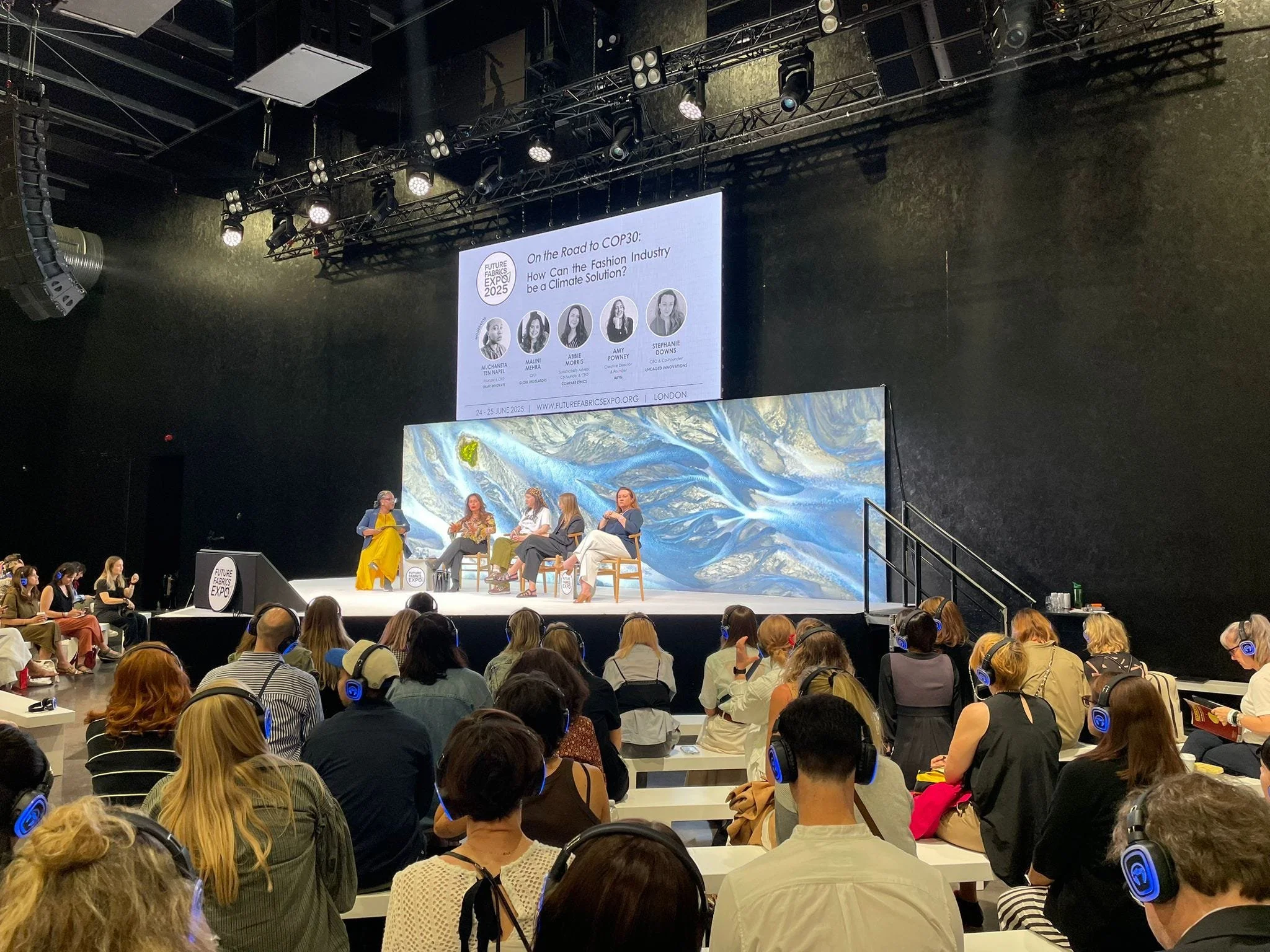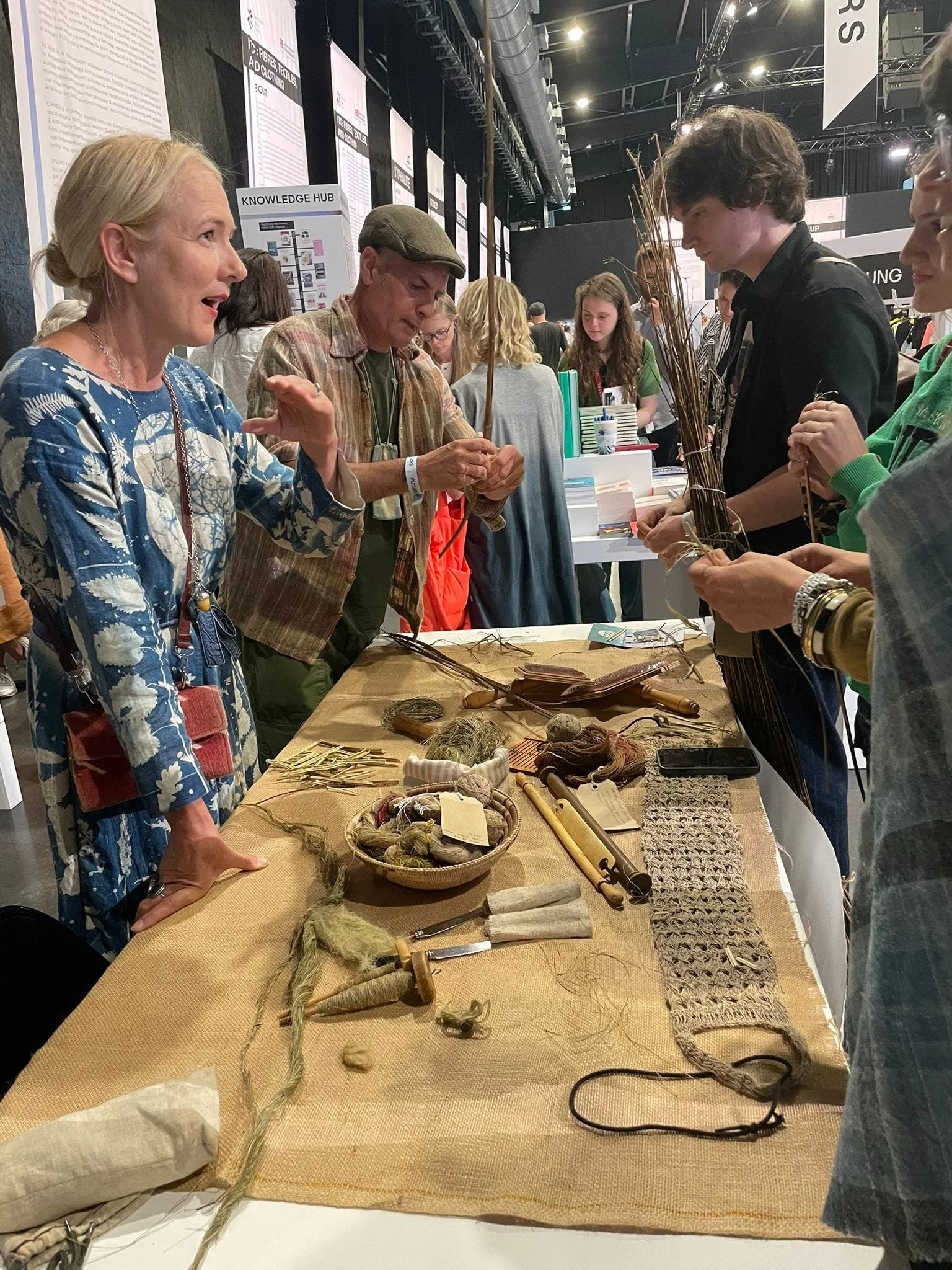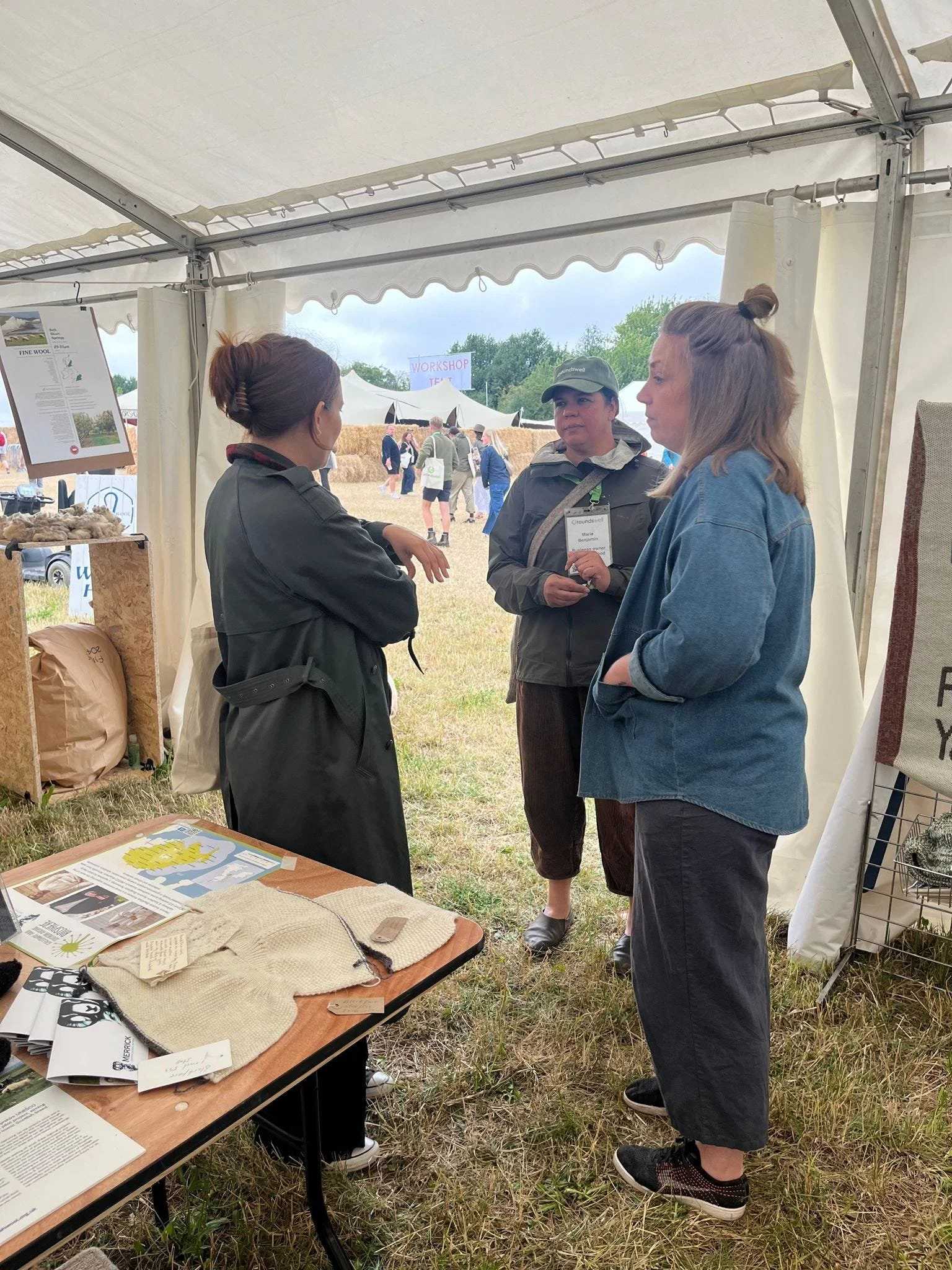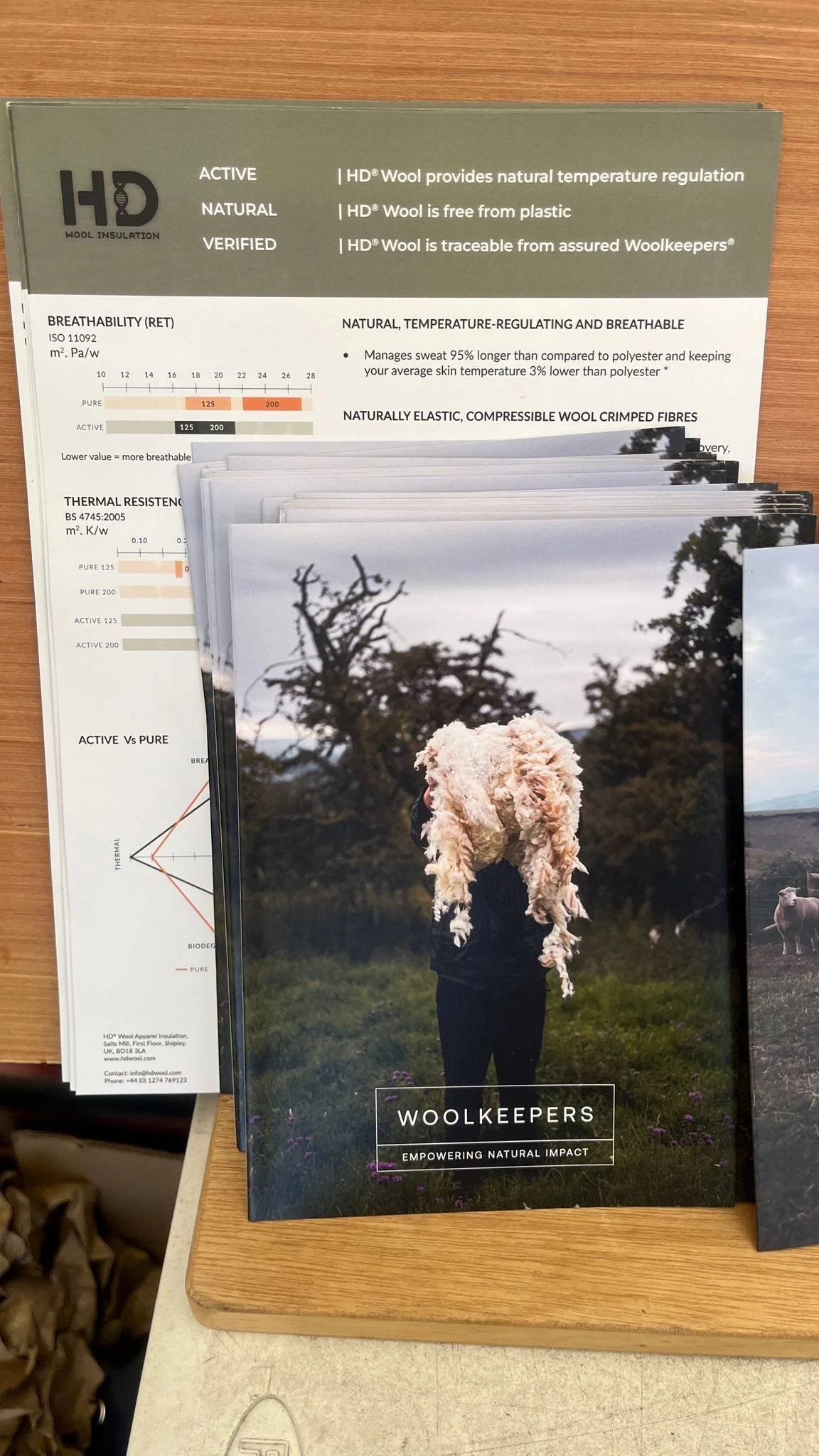Come BTS with Fashion Roundtable at Future Fabrics and Groundswell
Who else thinks the future is regenerative?
Harriet Fletcher-Gilhuys, Textiles Researcher at Fashion Roundtable (L) with Tamara Cincik, Founder and CEO of Fashion Roundtable (R). Image Credit: Jeremy Fusco
Fashion Roundtable and The Great British Wool Revival attended both the Future Fabrics Expo and Groundswell Agriculture festival, from bustling North Greenwich to the rolling flatland of the North Hertfordshire countryside.
The Sustainable Angle - Future Fabrics Expo
Firstly, we attended the Future Fabrics Expo (FFE), which is an eclectic combination of designers, industry professionals and innovation engineers to establish the future of the sustainable textiles industry. The two-day event covered a range of opportunities, from panel talks and discussions to table displays and demonstrations - FFE challenges current paradigms by bringing together a wide range of industry experts, creating a safe space for thoughts to be shared, analysed and criticised to establish the future of the fashion industry as we see it today.
We showcased both Fashion Roundtable and The Great British Wool Revival, with our map, and an educational table that displayed a variety of different British wool samples, natural dye swatches and raw fleeces - taking people on the journey from field to final product. Interest in this work was phenomenal.
On the Road to COP30: How Can the Fashion Industry be a Climate Solution? Panel discussion chaired by Muchaneta Ten Nepal, Founder and CEO of Shape Innovate. Malini Mehra (Globe Legislators) (L), Abbie Morris (Compare Ethics), Amy Powney (AKYN) and Stephanie Downs (Uncaged Innovations) (R). Image Credit: Harriet Fletcher-Gilhuys
Allan Brown showing his Nettle Dress demonstration with support from Zoe Burt, Textile Artist and Designer. Image Credit: Harriet Fletcher-Gilhuys
Groundswell
The Great British Wool Revival: from farmer to fashion
Located in the ‘Wool Hub’, The Great British Wool Revival was placed amongst a variety of wool initiatives from British Wool (former British Wool Marketing Board), The Wool Library, The London City Farm Yarn Project, Fibershed and many more.
On Wednesday 2nd July, we hosted a panel discussion The Great British Wool Revival: from farmer to fashion which was chaired by Tamara Cincik, Founder and CEO of Fashion Roundtable. This was an important step in linking regenerative fashion to farming.
The panellists where Alex Reynolds (Farming and Rural Skills Curriculum Manager at The King’s Foundation), Zoe Fletcher (The Wool Library), Jessica Horton (The Modern Artisan Designer) and Harriet Fletcher-Gilhuys (Textiles Researcher at Fashion Roundtable and lead on the GBWR).
Located in ‘The Study’, under a large wool tent the audience gathered from a range of diverse farming and sustainability backgrounds, to discuss the correlations between regenerative farming, slow food and regional fashion systems.
Harriet Fletcher-Gilhuys (L), Kevin Snowball (The Wool Keepers), Tamara Cincik and Jo Dawson (The Wool Keepers) (R). Image Credit: Jeremy Fusco
The Wool Library stand in the ‘Wool Hub’ at Groundswell. Image Credit: Jeremy Fusco
Jessica Horton (The Modern Artisan) (L), Maria Benjamin (The Wool Library) and Zoe Fletcher (The Wool Library) (R) in the ‘Wool Hub’. Image Credit: Jeremy Fusco
The Wool Keepers stand at Groundswell. Image Credit: Jeremy Fusco
The Wool Library yarn booklet at Groundswell. Image Credit: Jeremy Fusco
The panellists discussed a range of topics from the launch of the GBWR, the on-going pressures facing British wool producers today, the power of storytelling and the impacts of AI on both the fashion and farming industries. The panellists highlighted the intrinsic qualities that British wool has to offer - from unique storytelling opportunities, to its natural characteristics and tacit qualities and how all of this helps to support farmers in terms of income generation and future proofing jobs and years farming heritage. We will be sharing clips from the panel on our YouTube channel.
The subject of AI was raised - the general consensus was that we should be looking at ways that both nature and technology can work together, by using tools such as Digital Product Passports (DPP) and GreenStory as a platform to highlight the transparent properties that British wool has to offer. From 100% biodegradability to a cradle-to-cradle lifecycle assessment - all of these are frameworks and metrics that both engineers and designers work tirelessly to achieve.
While the development of bio-materials often aims to replicate these properties, it frequently overlooks the environmental toll involved in both the extraction and production processes. In contrast, British wool naturally possesses these qualities and stands out as a leader in fibre traceability and environmental accountability.
“In order to change a system and teach a new generation lost skills, we need to implement this at seed level - this is where education comes in” - Zoe Fletcher, The Wool Library
The Rare Breeds Survival Trust concluded the two-day event. They hosted an engaging talk covering a wide variety of rare-breed sheep, a breakdown of fleece quality and handle and how we can support these breeds to thrive even further by encouraging them to be bred for both meat and wool. They even touched on the history of ‘Waulking Songs’ in the Highlands of Scotland, where women traditionally waulked the cloth, often tweed to ensure felting and softening as part of the cloth's natural process.
“Wearing British wool is the oldest human to animal relationship - this is often overlooked when we talk about fashion. We’ve been wearing British wool since the start of all time and by wearing wool we can support livelihoods and rare breeds” - Alice Lennox from the Rare Breeds Survival Trust, during their talk on Wool with a Purpose: The Uses and Qualities of Native Breed Wool.
This aligns so closely with the work that we do at The Great British Wool Revival, re-connecting farmers with designers and rebuilding a broken wool system. By restoring these connections, we are bringing greater value and recognition back to farmers, sheep and their fleeces. This is a huge step in the regenerative transition, connecting farming, agriculture, fashion and food in an integrated system.








